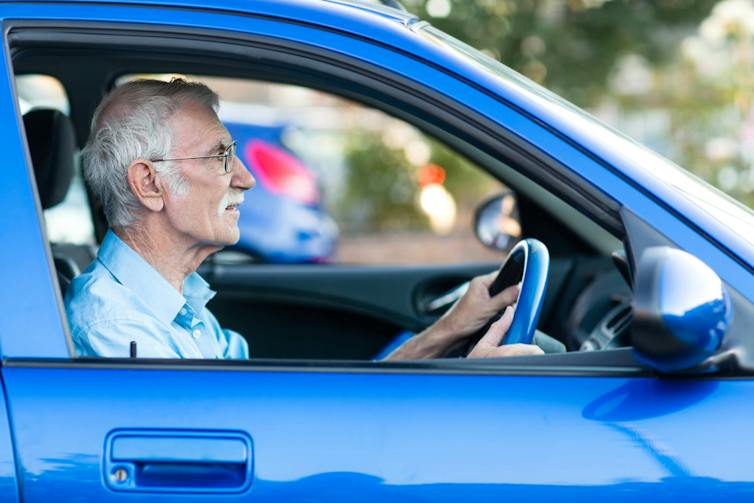Less than half of UK motorists surveyed by the Driver and Vehicle Licensing Agency (DVLA) know they must be able to read a number plate from 20 metres away in order to drive safely.
As a vision test, it’s quick and easy. It’s not difficult to find a number plate to conduct the eyesight test and the DVLA gives suggestions for approximating 20m – five car lengths or the width of eight parking bays. But is it a fair test of vision for driving?
As a rough and ready test, it’s easy to administer when you wouldn’t otherwise have a vision test to hand. However, there are significant variables: the amount of light, time of day, weather conditions, the person’s age, the colour and cleanliness of the number plate, and the actual letters and spacing, can make significant differences to how easy it is to read.
In UK ophthalmology clinics, visual acuity is measured and reported as a fraction, such as 6/6, 6/9 or 6/12 on the Snellen test. The numerator (number above the line) is the distance of the eye from the Snellen chart (in metres) and the denominator corresponds to the line of the letter chart. The largest letter on the chart usually represents 6/60 Snellen acuity. The smaller the denominator, the better the vision; the larger the denominator, the poorer the vision.
The test was created by the Dutch physician Hermann Snellen in the 1860s and is slowly being replaced by a newer test called LogMAR, which has more equal letter spacing. But, for now, driving requirements in the UK remain in Snellen.
People are pretty familiar with the term 20/20 vision, which is used to describe a good, clear, level of vision. The term 20/20 comes from the American model of measuring acuity, where the numerator refers to a 20-foot distance. Having 20/20 vision therefore equates to 6/6 vision in the UK on the Snellen chart, with a 6m numerator distance.
The crowding problem
To meet driving standards in the UK, you need to have a minimum 6/12 Snellen vision, a full visual field (the test of your peripheral vision) and also be able to read a number plate at 20m. Some people who meet the Snellen visual acuity and visual field requirements can’t see all of the letters of a number plate at 20m because of a phenomenon called crowding.
Crowding occurs when it is harder to identify a letter surrounded by other letters, than a letter on its own. It’s why the edge letters of the number plate are easier to identify than the middle letters.
There are some conditions in which people experience more crowding than others, such as amblyopia (lazy eye), glaucoma (increased pressure inside the eye resulting in nerve damage) and older age.
Crowding impairs people’s ability to recognise and respond to cluttered objects. It is not well understood, but we know it happens within the visual cortex – the vision processing part of the brain, because people experience crowding even when image clutter is presented separately to either eye.
In crowding, the “busier” and more cluttered the visual information being processed in the visual cortex, the more difficult the image segregation. It’s not that the objects cannot be seen, it’s that they cannot be effectively separated.
So is it fair or important that we continue to check visual acuity, including crowding with the 20m test?
The UK has an ageing population, working longer to retire and wanting to remain independent. In fact, the DVLA reports that the number of motorists aged 90 or older has doubled to more than 150,000 over the last decade.
ESB Professional/Shutterstock
Visual acuity shows weak, if any correlation with crash statistics or driving performance. Contrast sensitivity (the ability to differentiate shades of grey) may show better correlation, yet isn’t tested for driving at all.
A 2008 study found no reliable differences in crashes and serious accidents between Australian states with and without mandatory age-based fitness-to-drive vision testing.
Glare sensitivity, visual field loss, and useful field of view (the area you can extract visual information from in a single glance without moving your eyes) are significant predictors of driving accidents. And the useful field of view has been shown by several studies to play an important role in a person’s ability to drive safely.
Current driving tests, based primarily on visual acuity, may exclude some safe drivers and miss other important aspects of visual or cognitive impairment that are more directly related to driving ability.
While some might find the lack of legal eyesight requirement to drive a mobility scooter troubling, the social isolation and depression associated with stopping driving are also concerning.
Our current standards could be eliminating people from driving who would be good drivers according to better test predictors.
But, without a better test at the roadside, is it helpful to use a readily available number plate test – despite its flaws – to give an instant assessment rather than not have anything at all? Or would it be better to direct drivers to a more reliable test, taken within an appropriate time frame?
In an ageing population with increasing retirement ages such as the UK, this may be something we need to think about in the near future.




